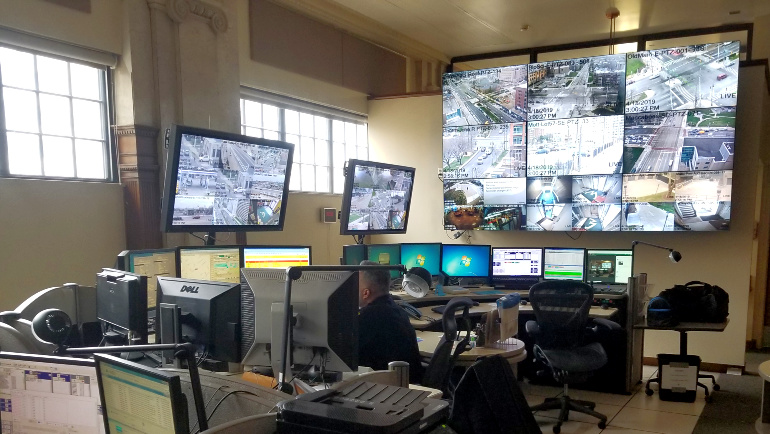
While police officers, firefighters and paramedics are considered first responders to an emergency, public safety dispatchers are the ones who make the initial contact.
“Unless someone is flagging an officer down, we’re the first to facilitate getting that person help,” said Wayne State University Police Department Officer Steven Heck, supervisor of communications and camera operations. “We do all the same things a traditional 911 call center would do, but we do much more than that.”
And like the first responders, Heck and the 12 communications controllers on his team have to remain calm, cool and collected in the face of stressful situations. Adding to this stress is the fact they can’t see the situation in front of them.
“We have to ask the appropriate questions to help paint a picture for the officers arriving on the scene and help them respond appropriately,” Heck said. “We try to get the officers as much information as possible to help them prepare.”
Heck is one of the thousands of dispatchers across the country who recently celebrated Public Safety Telecommunications week — held annually during the second week of April — which honors telecommunications personnel in the public safety community. The weeklong event — initially set up in 1981 by Patricia Anderson of the Contra Costa County Sheriff’s Office in California — is a time to celebrate and thank those who dedicate their lives to serving the public.
“The real first responders are the communication controllers. They take care of the safety of the citizens, the university, the students and our officers,” said WSUPD Chief Anthony Holt. “They are the lifeline of the department. Everything starts with the dispatchers.”
Heck and his dispatchers are available around the clock — 24/7, 365 days of the year — and it’s an occupation that will continue to need dedicated men and women. Employment of police, fire and ambulance dispatchers is projected to grow 8% from 2016 to 2026, according to the U.S. Department of Labor’s Bureau of Labor Statistics.
Heck, who has been with WSUPD for 14 years, said he’s never personally had to talk a person through delivering a baby, although it has happened during Holt’s tenure, or instruct a caller on how to give CPR — the latter mostly being thanks to WSUPD’s quick response rate. “The officers get there so fast and they administer the CPR immediately, if necessary,” Heck said.
When not answering calls, Heck and his team keep their eyes focused on eight screens, each directly in front of three separate communications controller’s stations in the department’s surveillance control room. This does not include a full wall of nine big screens they watch with particular crime hotspots that may need extra attention. WSUPD has one of the most extensive video surveillance systems in southeast Michigan, with more than 1,300 cameras, including high-definition cameras that can see for miles.
In addition to the campus and surrounding community reaching out to WSUPD dispatch for police and fire emergencies, the communications controllers’ team also fields calls for a variety of things. This includes helping students on campus who utilize what’s called “safe walks,” where they can call in and request to be monitored on one of the countless cameras as they walk home or between buildings.
“Our dispatch is a lot different than a 911 or Detroit dispatch,” Holt said. “There’s a multitude of things they are doing, and there’s not a free moment in there. I know very few people in the department who can do the job they do.”
To ensure a rapid and accurate response to incidents on and around campus, please contact WSUPD at 313-577-2222.
